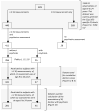Cognitive decline preceding the onset of psychosis in patients with 22q11.2 deletion syndrome
- PMID: 25715178
- PMCID: PMC4383767
- DOI: 10.1001/jamapsychiatry.2014.2671
Cognitive decline preceding the onset of psychosis in patients with 22q11.2 deletion syndrome
Abstract
Importance: Patients with 22q11.2 deletion syndrome (22q11DS) have an elevated (25%) risk of developing schizophrenia. Recent reports have suggested that a subgroup of children with 22q11DS display a substantial decline in cognitive abilities starting at a young age.
Objective: To determine whether early cognitive decline is associated with risk of psychotic disorder in 22q11DS.
Design, setting, and participants: Prospective longitudinal cohort study. As part of an international research consortium initiative, we used the largest data set of intelligence (IQ) measurements in patients with 22q11DS reported to date to investigate longitudinal IQ trajectories and the risk of subsequent psychotic illness. A total of 829 patients with a confirmed hemizygous 22q11.2 deletion, recruited through 12 international clinical research sites, were included. Both psychiatric assessments and longitudinal IQ measurements were available for a subset of 411 patients (388 with ≥1 assessment at age 8-24 years).
Main outcomes and measures: Diagnosis of a psychotic disorder, initial IQ, longitudinal IQ trajectory, and timing of the last psychiatric assessment with respect to the last IQ test.
Results: Among 411 patients with 22q11DS, 55 (13.4%) were diagnosed as having a psychotic disorder. The mean (SD) age at the most recent psychiatric assessment was 16.1 (6.2) years. The mean (SD) full-scale IQ at first cognitive assessment was lower in patients who developed a psychotic disorder (65.5 [12.0]) compared with those without a psychotic disorder (74.0 [14.0]). On average, children with 22q11DS showed a mild decline in IQ (full-scale IQ, 7.04 points) with increasing age, particularly in the domain of verbal IQ (9.02 points). In those who developed psychotic illness, this decline was significantly steeper (P < .001). Those with a negative deviation from the average cognitive trajectory observed in 22q11DS were at significantly increased risk for the development of a psychotic disorder (odds ratio = 2.49; 95% CI, 1.24-5.00; P = .01). The divergence of verbal IQ trajectories between those who subsequently developed a psychotic disorder and those who did not was distinguishable from age 11 years onward.
Conclusions and relevance: In 22q11DS, early cognitive decline is a robust indicator of the risk of developing a psychotic illness. These findings mirror those observed in idiopathic schizophrenia. The results provide further support for investigations of 22q11DS as a genetic model for elucidating neurobiological mechanisms underlying the development of psychosis.
Conflict of interest statement
Stephen R. Hooper has provided consultation to Novartis. Opal Ousley is a collaborator in a Biomarin Pharmaceutical study. None of the other authors have declared a conflict of interest.
Figures





Comment in
-
Cognitieve achteruitgang meetbaar jaren voor de eerste psychotische episode.Tijdschr Psychiatr. 2015;57(8):613-4. Tijdschr Psychiatr. 2015. PMID: 26437477 Dutch. No abstract available.
References
-
- Kraepelin E. In: Dementia praecox and paraphrenia (1919) Barclay RM, translator; Robertson GM, editor. New York: Robert E. Krieger; 1971.
-
- Reichenberg A, Weiser M, Rapp MA, et al. Elaboration on premorbid intellectual performance in schizophrenia: premorbid intellectual decline and risk for schizophrenia. Arch Gen Psychiatry. 2005;62(12):1297–1304. - PubMed
-
- Cannon TD, Bearden CE, Hollister JM, Rosso IM, Sanchez LE, Hadley T. Childhood cognitive functioning in schizophrenia patients and their unaffected siblings: a prospective cohort study. Schizophr Bull. 2000;26(2):379–393. - PubMed
-
- Bearden CE, Rosso IM, Hollister JM, Sanchez LE, Hadley T, Cannon TD. A prospective cohort study of childhood behavioral deviance and language abnormalities as predictors of adult schizophrenia. Schizophr Bull. 2000;26(2):395–410. - PubMed
-
- Cannon M, Caspi A, Moffitt TE, et al. Evidence for early-childhood, pan-developmental impairment specific to schizophreniform disorder: results from a longitudinal birth cohort. Arch Gen Psychiatry. 2002;59(5):449–456. - PubMed
Publication types
MeSH terms
Grants and funding
- U01 MH087626/MH/NIMH NIH HHS/United States
- MH-065481/MH/NIMH NIH HHS/United States
- U01 MH101719/MH/NIMH NIH HHS/United States
- R01 MH085953/MH/NIMH NIH HHS/United States
- MOP-89066/CAPMC/ CIHR/Canada
- R01 HD042974/HD/NICHD NIH HHS/United States
- U54 EB020403/EB/NIBIB NIH HHS/United States
- R01 MH064824/MH/NIMH NIH HHS/United States
- MOP-97800/CAPMC/ CIHR/Canada
- P50 HD055784/HD/NICHD NIH HHS/United States
- R01 MH078015/MH/NIMH NIH HHS/United States
- R01 HD-042974/HD/NICHD NIH HHS/United States
- 1U01MH101724-01/MH/NIMH NIH HHS/United States
- WT_/Wellcome Trust/United Kingdom
- MH-087636/MH/NIMH NIH HHS/United States
- R01 MH-085953/MH/NIMH NIH HHS/United States
- MH-078015/MH/NIMH NIH HHS/United States
- R01 MH065481/MH/NIMH NIH HHS/United States
- MH-087626/MH/NIMH NIH HHS/United States
- P50 HD-055784/HD/NICHD NIH HHS/United States
- U01 MH101722/MH/NIMH NIH HHS/United States
- U01 MH101720/MH/NIMH NIH HHS/United States
- R34 MH091314/MH/NIMH NIH HHS/United States
- MH-091314/MH/NIMH NIH HHS/United States
- R01 HD065280/HD/NICHD NIH HHS/United States
- MH-064824/MH/NIMH NIH HHS/United States
- U01 MH101724/MH/NIMH NIH HHS/United States
- U01 MH101723/MH/NIMH NIH HHS/United States
- MR/L010305/1/MRC_/Medical Research Council/United Kingdom
- HD-070454/HD/NICHD NIH HHS/United States
- R37 MH085953/MH/NIMH NIH HHS/United States
- MOP-74631/CAPMC/ CIHR/Canada
- U01 MH087636/MH/NIMH NIH HHS/United States
- P01 HD070454/HD/NICHD NIH HHS/United States
LinkOut - more resources
Full Text Sources
Other Literature Sources
Medical
Research Materials

